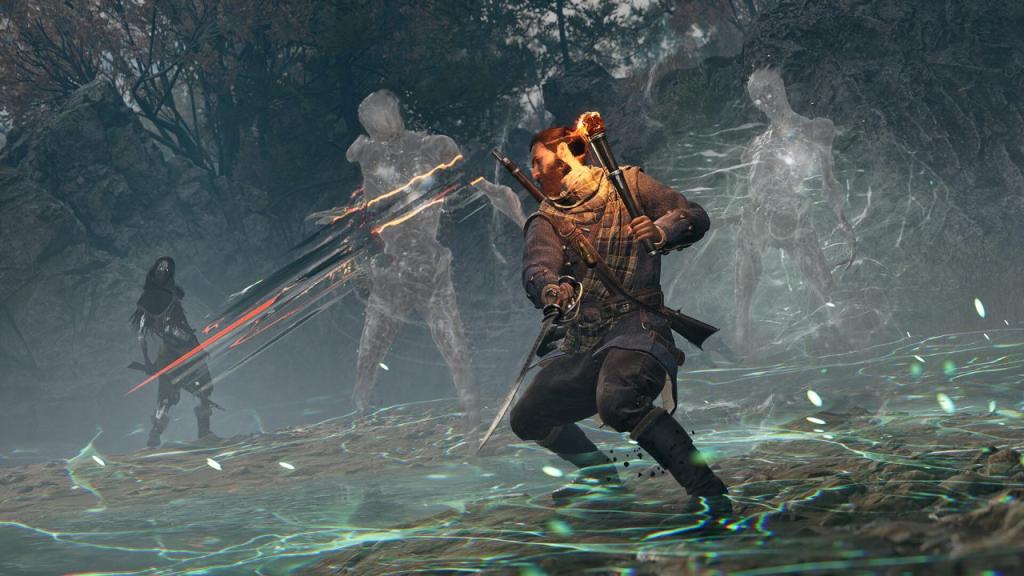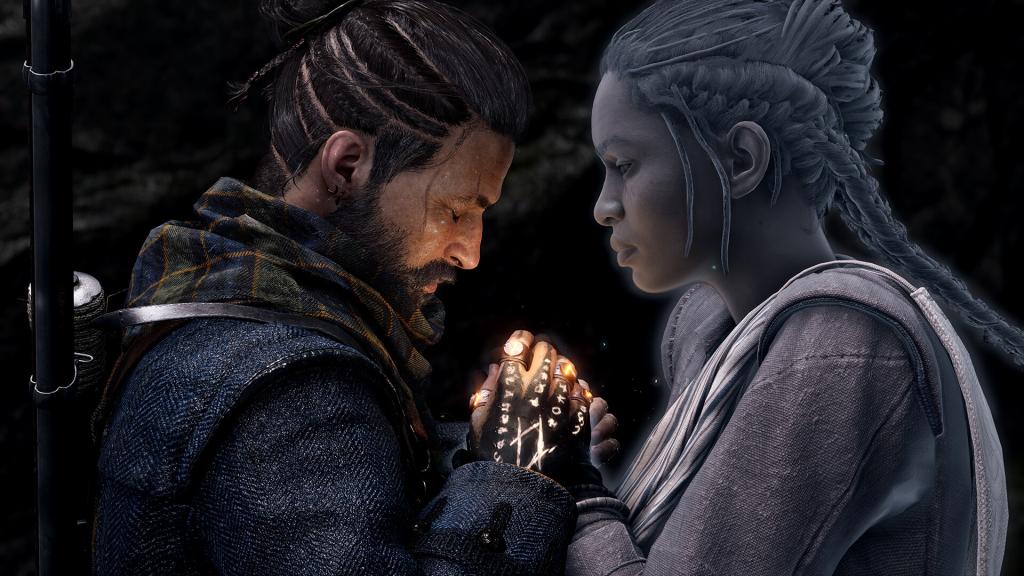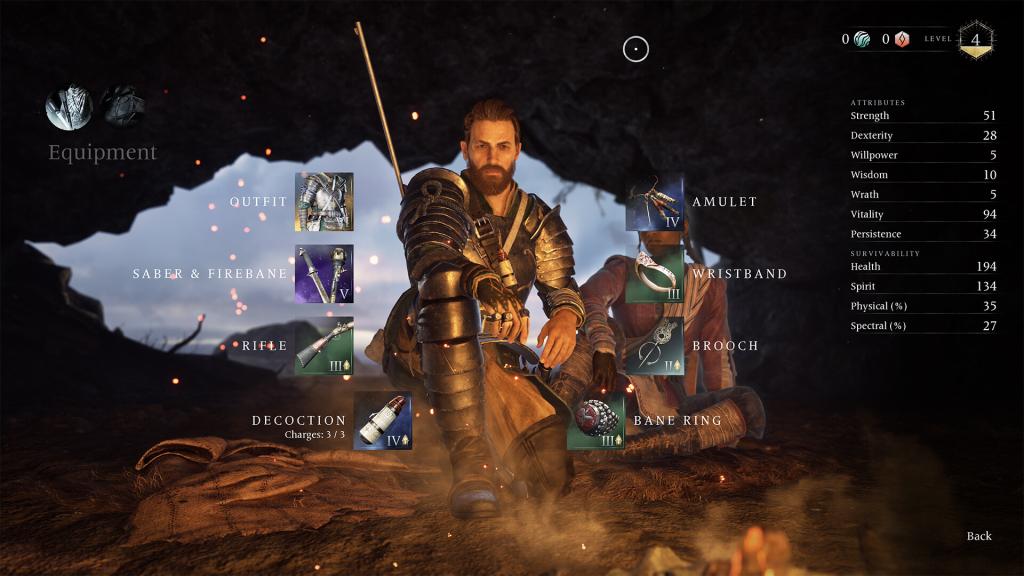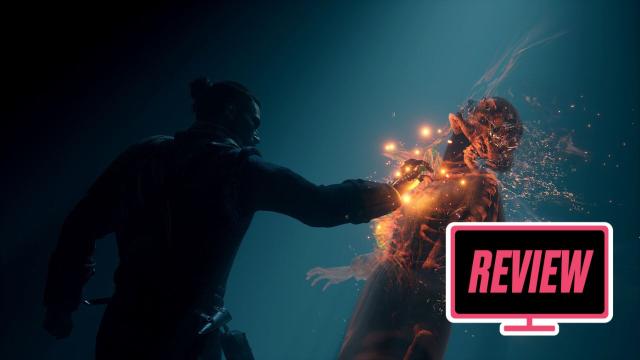Tucked away inside a small cave, two people sit by a fire. The man, gruff, stares longingly at his partner, a stoic woman, who stares back with a quiet tempest of feeling. Outside, wind and fog whip at the mouth of their temporary hideaway, the fire pushing and pulling his shadow as the two begin to talk about their future and the road they might walk to find it. They are Banishers, professional ghost hunters who deploy centuries of inherited knowledge to aid in a lingering spirit’s passing from this world to the next. This is their promise, their trade, their creed. They are in love, and she is dead.
Paradise Taken

When an old friend succumbs to a failed banishing ritual, Red mac Raith and Antea Duarte are summoned to New Eden, a truncated slice of colonised North American wilds in the early 1690s. A burgeoning coastal settlement is under siege from a powerful evil spectre, the Nightmare, whose violent assault on New Eden Town has driven all but the most devout and hardened from its streets. Here, with all the bravado and self-assured ideology of the young and the talented, the two banishers poke and prod at the edges of this haunting, standing proud in the certainty and clarity of their vow, “life to the living, death to the dead”. Here, still, they fail, Antea killed by the Nightmare, a far greater spirit than they imagined, and Red violently ejected from New Eden Town, baited by its ghost to return should he want his lover’s body back. Awakening on the opposite coast, Red finds himself haunted by Antea, who has retained her consciousness beyond the veil to resolve her untimely death.
From the moment the pair set foot on New Eden’s soil, Banishers: Ghosts of New Eden begins a conversation with the player about the nature of a haunting. It is the very core of the game; a thematic, political, and emotional anchor interwoven with its mechanics and every corner of its narrative. New Eden is a cursed land, but not always, or even often, in the way you might expect. Banishers: Ghosts of New Eden makes few concessions in its harsh critique of colonisation and its effects on a land and its people. However, its somewhat handwavy omission of indigenous understanding its haunted nature and leaving the area does allow the game an easier path through its efforts. Instead, it centres its narrative around an original sin committed by a collective force of hateful men and women, a literal and metaphorical representation of atrocities done to land and people.
Across the approximately twenty-odd hours Banishers takes to hit its most achievable ending, you’ll move through New Eden’s dense map, taking on haunting investigations, some core to the plot and many optional. Each case is a similar loop: You arrive at a marked spot, and talk to the locals. Then, you investigate a location to piece together a lingering spirit’s motive and target. Finally, you confront all parties to decide on a resolution. Despite a rather flashy menu indicating case-specific discoveries, the game’s insistence on highlighting the only necessary interactable in a location defuses the sense that you are actively participating in problem-solving or analysis. Still, it takes little away from DON’T NOD’s signature narrative design and character work. The same teeth found in the overarching plot bite just as hard in smaller cases. New Eden, you’ll find over and over, is a land rich and festering, with morally complex and dangerous cases, each demanding your services to solve.
First rite of refusal

For Red and Antea, though, resolution for the living comes at a high price. Banishers: Ghosts of New Eden’s marketing has not been shy about the central conflict of the game, with Antea’s death serving as a catalyst and pivot point for the narrative. In these two characters, DON’T NOD has crafted a tremendously compelling and deeply human portrayal of love and grief. The shared history between them is palpable, played out across dozens of intimate gestures, knowing glances, and lengthy, raw conversations. In the face of the impossible potential of being separated, their professional integrity collides with their commitment to each other, and the game gives you the choice between accepting the loss and imparting this lesson onto New Eden, or rejecting it, claiming as many lost souls as possible in service of a resurrection ritual.
Perhaps Banishers: Ghosts of New Eden’s greatest strength is its choice to not outright judge the player for either choice. There is peace in letting go, a dignity in the face of such tragedy that can and will impact those around Red and Antea. Equally justifiable is the vehement denial of their loss, both able to agree that this hateful land, which has taken so much already through the actions of its coloniser, will take no more from them. Antea’s own history as a Black woman is crucial to this emotional truth, of course — a cohesive bit of character work that ties directly into player choice. “Life to the living, death to the dead,” warping as the two openly defy their circumstances and the game bends to allow for such a morally complex course of action.
Emotionally, Banishers: Ghost of New Eden cuts deep with a clarity of purpose and razor-sharp intent. Mechanically, it often struggles to pierce the skin with dulled systems and meandering action RPG mainstays. Structurally, the game strings major haunting investigations together through a limited open-world map, each region offering large towns and minor instances of exploration. Through Antea’s growing set of spectral powers, you’ll gain access to previously walled-off spaces in the world, ostensibly encouraging repeated exploration to find better colour-graded loot. These spaces between settlements are frequently breathtaking, the game’s romanticised slant on natural beauty a sight to behold, the richness of New Eden’s natural splendour occasionally spilling over into something akin to overripe fruit, sickly sweet and rotting beyond the eye’s capacity to see but not the senses to notice.
Lumbering Sim

It’s also a chore to explore. Taking the worst lessons from Sony’s prestige playbook, Banishers: Ghosts of New Eden suffocates its gorgeous world with monotonous, linear exploration. Every lush valley, jagged cave, abandoned settlement, and interdimensional plane is packed with brightly marked spots to hold the stick through as Red shimmies through small gaps, along ledges, and up walls. Beyond these scripted animations, spaces can’t really be moved through or across, shallow creeks and short ledges proving too much of a barrier to the legendary ghost hunter. It flattens every space in the game, their aesthetic prowess and promise of the unknown nullified by how little you can interact with this world.
To liven up the journey through its painterly landscapes, Banishers: Ghosts of New Eden liberally deploys combat encounters. Not too dissimilar to its world, combat looks stunning; animations are often brutal and swift, Red’s gunshots echoing through valleys as Antea’s spectral powers enchant the battlefield with arcane symbols and lingering whisps. The two are interchangeable during combat, often combining physical attacks with ghostly spells for increased damage and crowd control. It’s all very functional, veering into genuine bursts of fun during the game’s impressive boss encounters but often becoming repetitive during repeated fights with a limited pool of enemy types. Technically, there are stats to consider, along with upgradeable gear, but these systems feel superfluous to the overall experience.
It coalesces into a game that, while overstuffed with some pretty perfunctory systems and the occasional bit of odd pacing around exploration, rises above thanks to its profoundly impactful narrative work and worldbuilding. Amaka Okafor and Russ Bain’s respective work as Antea and Red binds the experience with two gorgeous performances, equally matched in depth and consideration for a script that galvanises its politics and themes in its final hour. Provided you’ve chosen to make peace with your loss, Banishers: Ghosts of New Eden revels in its closing moments, pointedly leaving the player with a narrative about how fear and hatred of marginalised people is the deepest curse of New Eden and, however small and fictionalised, at least here you were able to bring some sense of justice to the world.
A Waking Nightmare
Minor mechanical and plot spoilers below. Putting a spoiler warning in just in case.

Of course, that’s all provided you choose correctly. Banishers: Ghosts of New Eden saves its gravest error for the closing minutes of the game’s second path, the one in which Red and Antea reject her death and pursue resurrection. The game presents the choices fairly early on, just moments after your first proper investigation, and then again about halfway through the story, both times prompting you that in order to bring Antea back, you’ll need to sacrifice as many souls of New Eden as possible to do so. This is a harrowing affair each time, and, again, a credit to DON’T NOD’s writing that it takes as much of a toll as it does. But given the ability to change paths midway through the game, most players would likely assume that their choices from that point on would count toward their end goal.
Instead, Banishers: Ghost of New Eden seems to have an all-or-nothing system operating in the background, as my attempt to bring Antea back was met with a rather bizarre heel turn. While the potential need to 100% all haunting cases in the game (upwards of 30 hours of play) is mildly frustrating given the ease with which the other ending is achievable, it’s the game’s outlandish narrative turn that entirely undoes the experience. Without too many details, this other ending posits that yes, while the sins of the people of New Eden may have indeed been horrific, have you considered that it would all be justified in the end? That the justice you sought for those wronged would be cheaply discarded by a literal last-minute character twist? It is an egregious moment of writing for an otherwise fantastic work, buried under the game’s less desirable path and potentially only “fixable” by a completionist run-through.
At this point, I looked at the map, littered with dozens of cases I could investigate in this hateful land. Dozens of souls to burn on the pyre of my goal, which had now been extrapolated into a metatextual quest to understand if Banishers: Ghosts of New Eden had actually just compromised itself so thoroughly in service of a distasteful gotcha moment. I looked at it, and I said…no. Here was a game that I had spent nearly twenty hours with, ruminating on the fickle and often cruel nature of life. In this sense, I suppose it was largely successful.
I have no clue how much time I have left, how many more years or months or days with those I love, to touch grass or taste a nice dish or pat my dog. I don’t know if the game’s other ending is better, but I know I’ve got only one round at this, so I closed the game and went outside. Life to the living, death to the dead.
Review conducted on PlayStation 5 with a pre-release code provided by the publisher.
Image: Focus Home Entertainment, Kotaku Australia

Leave a Reply